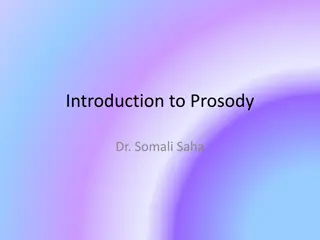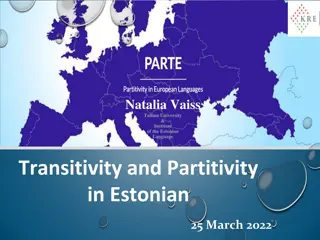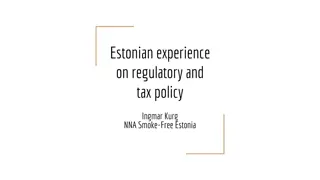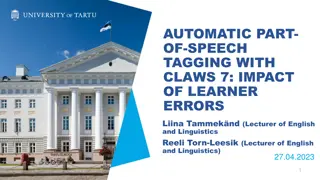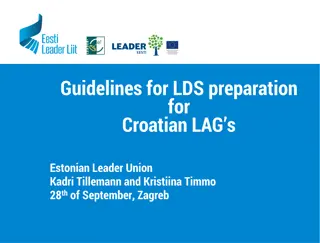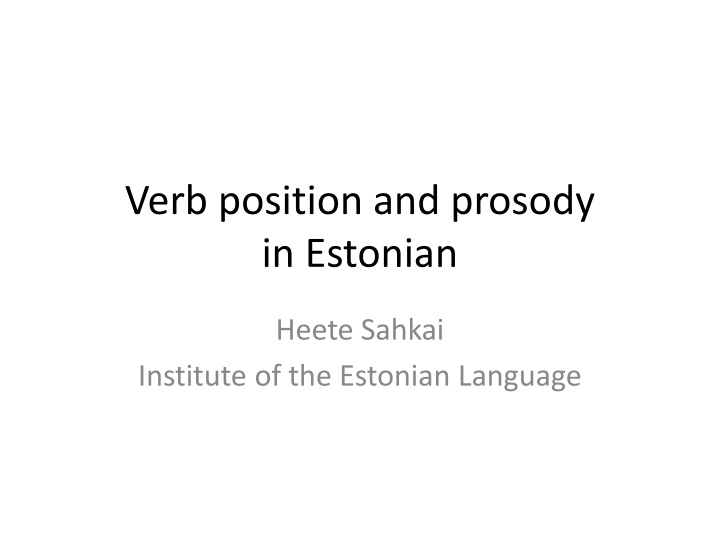
Verb Placement and Prosody in Estonian
The generalizations and exceptions in verb placement in Estonian suggest interactions between syntax and prosody. The V2 phenomenon in Estonian is linked to prosody, impacting subject-verb order. The presentation discusses variations in verb placement based on prosodic structure and accentuation of the finite verb in declarative sentences.
Download Presentation

Please find below an Image/Link to download the presentation.
The content on the website is provided AS IS for your information and personal use only. It may not be sold, licensed, or shared on other websites without obtaining consent from the author. If you encounter any issues during the download, it is possible that the publisher has removed the file from their server.
You are allowed to download the files provided on this website for personal or commercial use, subject to the condition that they are used lawfully. All files are the property of their respective owners.
The content on the website is provided AS IS for your information and personal use only. It may not be sold, licensed, or shared on other websites without obtaining consent from the author.
E N D
Presentation Transcript
Verb position and prosody in Estonian Heete Sahkai Institute of the Estonian Language
Introduction The generalisations that can be formulated about verb placement in Estonian have exceptions that seem to be more easily described in terms of prosody than in terms of syntax or information structure, suggesting that the syntactic constraints on verb position may interact with prosodic constraints. Estonian is generally described as a V2 language (e.g. Tael 1990, Huumo 1994, Erelt 2009). Second-position phenomena generally have a prosodic aspect, being enclitic. The Estonian V2 has also been associated with prosody by Tael (1990:34) who seems to view V2 as a syntactic phenomenon which has a prosodic motivation historically.
Goal To present two types of variation in verb placement that can occur in simple declarative all-new sentences: Variation in V2 depending on the accentuation of the finite verb The respective placement of subject and verb after sentence-initial adverbials The respective placement of verbs and sentence adverbs Variation depending on the prosodic phrase structure of the sentence
V2 and sentence-initial adverbials 1 By default, the subject precedes the verb (a). The V2 effect: When the sentence begins with an adverbial expression, the order of the subject and the verb is inverted , i.e. the verb precedes the subject (b). a. ks mees leidis kahtlase paki one.nom man.nom find.past.3sg suspicious.gen package.gen A man found a suspicious package b. M ni p ev hiljem leidis ks mees some.nom day.nom later find.past.3sg one.nom man.nom kahtlase paki suspicious.gen package.gen lit. A few days later found a man a suspicious package c. *M ni p ev hiljem ks mees (leidis) kahtlase paki (leidis)
V2 and sentence-initial adverbials 2 Variation: under certain circumstances, the inversion does not or need not take place, i.e. the verb may be preceded both by the adverbial expression and the subject, ceasing to be in the second position. These circumstances can be given a prosodic description: the inversion becomes optional or dispreferred when the finite verb carries the nuclear accent. Although nuclear accent placement is determined by syntax, there can be exceptions to this, which suggests that verb placement cannot by reduced to syntax.
V2 and sentence-initial adverbials 3 Intransitive verb: a. M ni p ev hiljem ks mees some day later A few days later a man disappeared b. ?M ni p ev hiljem kadus ks mees kadus one.nom man.nom disappear.past.3sg
However, the variation cannot be described in terms of intransitivity: the intransitive verb occurs in the second position when it is the finite element of a complex predicate (a, b), or when another element receives the nuclear accent (c, d): a. M ni p ev hiljem olevat ks mees kadunud some day later aux.evid one man disappear.prtcpl A few days later a man reportedly disappeared a . *M ni p ev hiljem ks mees olevat kadunud b. M ni p ev hiljem kadus ks mees ra some day later disappear.past.3sg one man prtcl A few days later a man disappeared b. ?M ni p ev hiljem ks mees kadus ra c. M ni p ev hiljem kadus ks mees some day later disappear.past.3sg one man d. M ni p ev hiljem kadus ks mees ootamatult some day later disappear.past.3sg one man unexpectedly
Examples like (c) and (d) cannot be given a syntactic description: the placement of the accent on the subject or the adjunct is not syntactically determined and would not be possible in an all-new transitive sentence. Rather, to the extent that it is possible, it permits to satisfy the V2 constraint without violating the prosodic constraint.
V2 and sentence-initial adverbials 4 V2 may also be absent from transitive sentences where the verb receives the nuclear accent for information structural reasons, e.g. the argument is given/pronominal: (Context: I lost my phone) a. M ni p ev hiljem ks mees leidis selle some day later one man found it A few days later a man found it a . ?M ni p ev hiljem leidis ks mees selle some day later found one man it b. M ni p ev hiljem leidis ks mees selle les some day later found one man it A few days later a man found it prtcl
V2 and sentence-initial adverbials: Summary 1 The generalisation whereby a sentence-inital adverbial causes the verb to precede the subject does not seem to hold when the verb receives the nuclear accent, i.e. V2/verb movement seems to be subject to an operative prosodic constraint. Earlier descriptions of the lack of inversion also propose a prosodic account, assuming that the inversion becomes optional when the subject is short and unstressed, i.e. pronominal (Tael 1990:34, Lindstr m 2017). It should be examined whether the prosodic properties of the subject are a factor that operates independently of the prosodic properties of the verb.
It does not seem evident that the properties of the subject alone can override V2 when the verb is unaccented, i.e. (b) does not seem substantially better than (a): a. ?M ni p ev hiljem ks mees some day later one.nom man.nom find.past.3sg kahtlase paki suspicious.gen package.gen lit. A few days later a man found a suspicious package leidis b. ?M ni p ev hiljem ta leidis kahtlase paki some day later 3sg find.past.3sg suspicious.gen package.gen lit. A few days later he found a suspicious package
V2 and sentence-initial adverbials: Summary 2 The second position does not seem to be compatible with the nuclear accent. However, this does not seem to mean that the verb is enclitic on the preceding word: a sentence like (a) seems acceptable with a prenuclear accent on the verb and a break between the adverbial and the verb: a. M ni p ev hiljem kadus some day later disappear.past.3sg one man unexpectedly A few days later a man disappeared unexpectedly ks mees ootamatult
V2 and sentence adverbs 1 That nuclear-accented verbs do not occur in second position is also suggested by the respective placement of verbs and sentence adverbs Second position verbs precede sentence adverbs: a. ks mees leidis v idetavalt kahtlase paki one man found reportedly suspicious.gen package.gen A man reportedly found a suspicious package a . * ks mees v idetavalt leidis kahtlase paki one man reportedly found suspicious.gen package.gen b. M ni p ev hiljem leidis ks mees v idetavalt kahtlase some day later found one man reportedly suspicious.gen paki package.gen
V2 and sentence adverbs 2 When the verb receives the nuclear accent, e.g. in case of a simple intransitive verb, it preferably follows the adverb: a. ks mees v idetavalt kadus one man reportedly disappeared A man reportedly disappeared a . ? ks mees kadus v idetavalt one man disappeared reportedly b. M ni p ev hiljem ks mees v idetavalt kadus some day later one man reportedly disappeared
V2 and sentence adverbs 3 Again, in case of complex predicates, the usual order is restored: a. ks mees olevat v idetavalt kadunud one man aux.evid reportedly disappear.prtcpl b. ?? ks mees v idetavalt olevat kadunud one man reportedly aux.evid disappear.prtcpl
V2 and sentence adverbs 4 Again, the same phenomenon appears in information-structurally marked transitive sentences: a. ks mees v idetavalt leidis selle one man reportedly found it A man reportedly found it a . ?? ks mees leidis selle v idetavalt one man found it b. ks mees leidis selle v idetavalt les one man found it A man reportedly found it reportedly reportedly prtcl
Prosody and verb-final order Prosodically induced variation can also occur in contexts where V2 alternates with verb-final order. In contexts that do not require V2, the order is usually verb-final (SOV). The alternation between the clause-final and second position has been attributed to information structure: the verb is final when it is focussed (Tael 1988:42, Lindstr m 2017:558). However, again, the alternation could be associated more generally with the accentuation of the verb (cf. Tamm 2008).
Prosody and verb-final order Alternation of V2 and V-final order in an all-new declarative subordinate clause (unaccented verb): a. Kui keegi (leiab) juhuslikult if somebody find.3sg incidentally kahtlase paki suspicious.gen package.gen find.3sg If somebody should find a suspicious package (leiab)
Prosody and verb-final order Preference for the V-final order in case of an accented verb: a. Kui keegi (?leiab) selle juhuslikult (leiab) if somebody find.3sg it.gen incidentally find.3sg If somebody should find it b. Kui keegi (?kaob) if somebody disappear.3sg incidentally disappear.3sg If somebody should disappear juhuslikult (kaob)
Conclusion on V2 and prosody When accounting for the V2 property of Estonian it seems necessary to take into account an apparently prosodic constraint which cannot be reduced to syntactic or information structural factors: apparently, the second position is not compatible with the nuclear accent, without at the same time being enclitic.
Single-accent (single-phrase) sentences Generalisation: In a simple all-new declarative V2 sentence the subject is the initial constituent. When there is no subject, another constituent occurs in the initial position. Variation: under certain circumstances, this generalisation becomes partly optional. These circumstances can again be described in prosodic terms: the verb is unaccented and there is a single other (overt) constituent with which the verb constitutes a single prosodic unit. In this case the respective order of the verb and the other constituent becomes free, independently of the syntactic conditions.
Default order in simple declarative all-new sentences with and without a subject Overt subject S - V - XP - XP *V - S - XP - XP *XP - V - S - XP Naabrid grillivad aias vorste neighbours barbecue.3pl garden.ine sausage.par.pl The neighbours are barbecuing sausages in the garden Subject pro-drop V - XP - XP *XP - V - XP Grillime aias vorste barbecue.1pl garden.ine sausage.par.pl No subject XP - V - XP *V - XP - XP Aias grillitakse vorste garden.ine barbecue.impers sausage.par.pl
(Overt subject) S - V / *V - S Naabrid grillivad / *Grillivad naabrid neighbours barbecue.3pl ks mees helistas / Helistas ks mees one man call.past.3sg A man called S - V / V - S Subject pro-drop V - XP / *XP - V Grillime aias / *Aias grillime barbecue.1pl garden.ine Grillime vorste / Vorste grillime barbecue.1pl sausage.par.pl V - XP / XP - V No subject XP - V / *V - XP Aias grillitakse / *Grillitakse aias garden.ine barbecue.impers Vorste grillitakse / Grillitakse vorste sausage.par.pl barbecue.impers XP - V / V - XP
Single-phrase sentences: summary When the verb in unaccented and there is a single other (overt) constituent the verb constitutes a single prosodic unit with it, being either initial or final.
Conclusion Prosodic notions are necessary in order to describe certain facts about Estonian word order. Nuclear accented verbs are not preferred in the second position. When the verb in unaccented and there is a single other (overt) constituent the verb constitutes a single prosodic unit with it, where the order is free.
References Erelt, M. 2009. Typological overview of Estonian syntax. Sprachtypologie und Universalienforschung 62: 6 28. Huumo, T. 1994. N k kulmia suomen ja viron sanaj rjestyseroihin. L hivertailuja 8, 21 39. Lindstr m, L. 2017. Lause infostruktuur ja s naj rg . In M. Erelt and H. Metslang, eds. Eesti keele s ntaks. (Eesti keele varamu, 3.), 547 565. Tartu: Tartu likooli Kirjastus. Tael, K. 1990. An approach to word order problems in Estonian. Tallinn: Eesti Teaduste Akadeemia. Tamm, A. 2008. Problems of automatic accent assignment: A comparison of Hungarian and Estonian verbs. Presentation at Budapest Uralic Workshop 6, 11-12 January 2008
Acknowledgements This research has been supported by the Centre of Excellence in Estonian Studies (CEES, European Regional Development Fund) and is related to the research project IUT35-1 (Estonian Research Council). This presentation was made possible by the projects Contact-induced change in Finno-Ugric languages (Hungarian Academy of Sciences, Estonian Academy of Sciences) and EKI-ASTRA (Institute of the Estonian Language, European Regional Development Fund).


